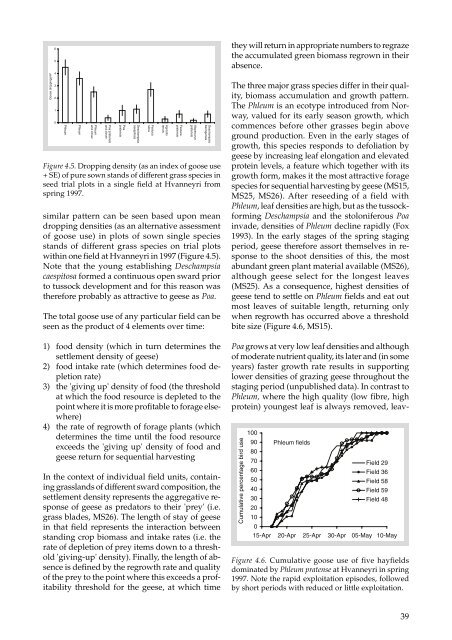The Greenland White-fronted Goose Anser albifrons flavirostris
The Greenland White-fronted Goose Anser albifrons flavirostris
The Greenland White-fronted Goose Anser albifrons flavirostris
Create successful ePaper yourself
Turn your PDF publications into a flip-book with our unique Google optimized e-Paper software.
<strong>Goose</strong> droppings/m 2<br />
6<br />
5<br />
4<br />
3<br />
2<br />
1<br />
0<br />
Phleum<br />
Phleum<br />
Phleum<br />
and clover<br />
Poa pratensis<br />
and clover<br />
Poa<br />
pratensis<br />
Figure 4.5. Dropping density (as an index of goose use<br />
+ SE) of pure sown stands of different grass species in<br />
seed trial plots in a single field at Hvanneyri from<br />
spring 1997.<br />
similar pattern can be seen based upon mean<br />
dropping densities (as an alternative assessment<br />
of goose use) in plots of sown single species<br />
stands of different grass species on trial plots<br />
within one field at Hvanneyri in 1997 (Figure 4.5).<br />
Note that the young establishing Deschampsia<br />
caespitosa formed a continuous open sward prior<br />
to tussock development and for this reason was<br />
therefore probably as attractive to geese as Poa.<br />
<strong>The</strong> total goose use of any particular field can be<br />
seen as the product of 4 elements over time:<br />
1) food density (which in turn determines the<br />
settlement density of geese)<br />
2) food intake rate (which determines food depletion<br />
rate)<br />
3) the 'giving up' density of food (the threshold<br />
at which the food resource is depleted to the<br />
point where it is more profitable to forage elsewhere)<br />
4) the rate of regrowth of forage plants (which<br />
determines the time until the food resource<br />
exceeds the 'giving up' density of food and<br />
geese return for sequential harvesting<br />
In the context of individual field units, containing<br />
grasslands of different sward composition, the<br />
settlement density represents the aggregative response<br />
of geese as predators to their 'prey' (i.e.<br />
grass blades, MS26). <strong>The</strong> length of stay of geese<br />
in that field represents the interaction between<br />
standing crop biomass and intake rates (i.e. the<br />
rate of depletion of prey items down to a threshold<br />
'giving-up' density). Finally, the length of absence<br />
is defined by the regrowth rate and quality<br />
of the prey to the point where this exceeds a profitability<br />
threshold for the geese, at which time<br />
Deschampsia<br />
caespitosa<br />
Festuca<br />
rubra<br />
Agrostis<br />
tenuis<br />
Festuca<br />
pratensis<br />
Alopecurus<br />
pratensis<br />
Deschampsia<br />
beringensis<br />
they will return in appropriate numbers to regraze<br />
the accumulated green biomass regrown in their<br />
absence.<br />
<strong>The</strong> three major grass species differ in their quality,<br />
biomass accumulation and growth pattern.<br />
<strong>The</strong> Phleum is an ecotype introduced from Norway,<br />
valued for its early season growth, which<br />
commences before other grasses begin above<br />
ground production. Even in the early stages of<br />
growth, this species responds to defoliation by<br />
geese by increasing leaf elongation and elevated<br />
protein levels, a feature which together with its<br />
growth form, makes it the most attractive forage<br />
species for sequential harvesting by geese (MS15,<br />
MS25, MS26). After reseeding of a field with<br />
Phleum, leaf densities are high, but as the tussockforming<br />
Deschampsia and the stoloniferous Poa<br />
invade, densities of Phleum decline rapidly (Fox<br />
1993). In the early stages of the spring staging<br />
period, geese therefore assort themselves in response<br />
to the shoot densities of this, the most<br />
abundant green plant material available (MS26),<br />
although geese select for the longest leaves<br />
(MS25). As a consequence, highest densities of<br />
geese tend to settle on Phleum fields and eat out<br />
most leaves of suitable length, returning only<br />
when regrowth has occurred above a threshold<br />
bite size (Figure 4.6, MS15).<br />
Poa grows at very low leaf densities and although<br />
of moderate nutrient quality, its later and (in some<br />
years) faster growth rate results in supporting<br />
lower densities of grazing geese throughout the<br />
staging period (unpublished data). In contrast to<br />
Phleum, where the high quality (low fibre, high<br />
protein) youngest leaf is always removed, leav-<br />
Cumulative percentage bird use<br />
100<br />
90<br />
80<br />
Phleum fields<br />
70<br />
Field 29<br />
60<br />
Field 36<br />
50<br />
Field 58<br />
40<br />
Field 59<br />
30<br />
20<br />
10<br />
0<br />
Field 48<br />
15-Apr 20-Apr 25-Apr 30-Apr 05-May 10-May<br />
Figure 4.6. Cumulative goose use of five hayfields<br />
dominated by Phleum pratense at Hvanneyri in spring<br />
1997. Note the rapid exploitation episodes, followed<br />
by short periods with reduced or little exploitation.<br />
39


